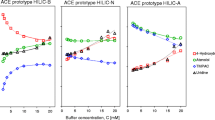Summary
A chromatographic model able to predict, from experimental isocratic data, retention times of solutes under gradient conditions has been proposed previously. The prediction was shown to be totally independent of the chemical properties of both solutes and eluents. In order to further check the general validity of the theory, the model has now been applied to a nonhomologous set of compounds, namely a range of substituted quinolines (methyl-, hydroxy- and amino-) and several different stationary phases. Results show a dependence on the stationary phase and, to a lesser extent, on the chemical structure of the solutes. The possible sources of errors are discussed. The generality of the method holds, within acceptable limits, if predictions concern the same type of stationary phase.
Similar content being viewed by others
References
E. Marengo, M. C. Gennaro, C. Baiocchi, P. Bertolo, Chromatographia25, 413 (1988).
L. R. Snyder, J. J. Kirkland, “Introduction to Modern Liquid Chromatography”, second edition, Wiley Interscience, pagg. 278–279 (1979).
C. Horváth, W. Melander, I. Molnár, J. Chromatogr.125, 129 (1976).
Author information
Authors and Affiliations
Rights and permissions
About this article
Cite this article
Marengo, E., Baiocchi, C., Gennaro, M.C. et al. Prediction of HPLC retention times in gradient elution from isocratic data application to a set of non-homologous compounds and different stationary phases. Chromatographia 27, 19–23 (1989). https://doi.org/10.1007/BF02290398
Received:
Accepted:
Issue Date:
DOI: https://doi.org/10.1007/BF02290398




